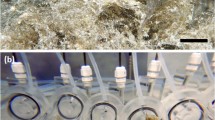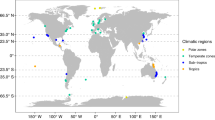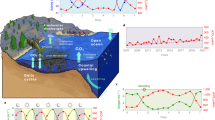Abstract
The partial pressure of CO2 in the oceans has increased rapidly over the past century, driving ocean acidification and raising concern for the stability of marine ecosystems1,2,3. Coral reef fishes are predicted to be especially susceptible to end-of-century ocean acidification on the basis of several high-profile papers4,5 that have reported profound behavioural and sensory impairments—for example, complete attraction to the chemical cues of predators under conditions of ocean acidification. Here, we comprehensively and transparently show that—in contrast to previous studies—end-of-century ocean acidification levels have negligible effects on important behaviours of coral reef fishes, such as the avoidance of chemical cues from predators, fish activity levels and behavioural lateralization (left–right turning preference). Using data simulations, we additionally show that the large effect sizes and small within-group variances that have been reported in several previous studies are highly improbable. Together, our findings indicate that the reported effects of ocean acidification on the behaviour of coral reef fishes are not reproducible, suggesting that behavioural perturbations will not be a major consequence for coral reef fishes in high CO2 oceans.
This is a preview of subscription content, access via your institution
Access options
Access Nature and 54 other Nature Portfolio journals
Get Nature+, our best-value online-access subscription
$29.99 / 30 days
cancel any time
Subscribe to this journal
Receive 51 print issues and online access
$199.00 per year
only $3.90 per issue
Buy this article
- Purchase on Springer Link
- Instant access to full article PDF
Prices may be subject to local taxes which are calculated during checkout




Similar content being viewed by others
Data availability
The data necessary to reproduce figures and results in this study are publicly archived in Figshare following best-practice guidelines55, and were made available to editors and reviewers at the time of submission: https://doi.org/10.6084/m9.figshare.7871522. We place no restrictions on data availability.
Code availability
Scripts for statistical analyses are available from Figshare (https://doi.org/10.6084/m9.figshare.7871522). We place no restrictions on code availability.
References
Hönisch, B. et al. The geological record of ocean acidification. Science 335, 1058–1063 (2012).
Lüthi, D. et al. High-resolution carbon dioxide concentration record 650,000–800,000 years before present. Nature 453, 379–382 (2008).
Riebesell, U. & Gattuso, J.-P. Lessons learned from ocean acidification research. Nat. Clim. Change 5, 12–14 (2015).
Dixson, D. L., Munday, P. L. & Jones, G. P. Ocean acidification disrupts the innate ability of fish to detect predator olfactory cues. Ecol. Lett. 13, 68–75 (2010).
Munday, P. L. et al. Replenishment of fish populations is threatened by ocean acidification. Proc. Natl Acad. Sci. USA 107, 12930–12934 (2010).
Ishimatsu, A., Hayashi, M., Lee, K.-S., Kikkawa, T. & Kita, J. Physiological effects on fishes in a high-CO2 world. J. Geophys. Res. Oceans 110, C09S09 (2005).
Heuer, R. M. & Grosell, M. Physiological impacts of elevated carbon dioxide and ocean acidification on fish. Am. J. Physiol. Regul. Integr. Comp. Physiol. 307, R1061–R1084 (2014).
Melzner, F. et al. Physiological basis for high CO2 tolerance in marine ectothermic animals: pre-adaptation through lifestyle and ontogeny? Biogeosciences 6, 2313–2331 (2009).
Munday, P. L. et al. Ocean acidification impairs olfactory discrimination and homing ability of a marine fish. Proc. Natl Acad. Sci. USA 106, 1848–1852 (2009).
Shaw, E. C., McNeil, B. I. & Tilbrook, B. Impacts of ocean acidification in naturally variable coral reef flat ecosystems. J. Geophys. Res. Oceans 117, C03038 (2012).
Clements, J. C. & Hunt, H. L. Marine animal behaviour in a high CO2 ocean. Mar. Ecol. Prog. Ser. 536, 259–279 (2015).
McNeil, B. I. & Sasse, T. P. Future ocean hypercapnia driven by anthropogenic amplification of the natural CO2 cycle. Nature 529, 383–386 (2016).
Leis, J. M. Paradigm lost: ocean acidification will overturn the concept of larval-fish biophysical dispersal. Front. Mar. Sci. 5, 47 (2018).
Bignami, S., Sponaugle, S. & Cowen, R. K. Response to ocean acidification in larvae of a large tropical marine fish, Rachycentron canadum. Glob. Change Biol. 19, 996–1006 (2013).
Sundin, J., Amcoff, M., Mateos-González, F., Raby, G. D. & Clark, T. D. Long-term acclimation to near-future ocean acidification has negligible effects on energetic attributes in a juvenile coral reef fish. Oecologia 190, 689–702 (2019).
Munday, P. L., Cheal, A. J., Dixson, D. L., Rummer, J. L. & Fabricius, K. E. Behavioural impairment in reef fishes caused by ocean acidification at CO2 seeps. Nat. Clim. Change 4, 487–492 (2014).
Nilsson, G. E. et al. Near-future carbon dioxide levels alter fish behaviour by interfering with neurotransmitter function. Nat. Clim. Change 2, 201–204 (2012).
Button, K. S. et al. Power failure: why small sample size undermines the reliability of neuroscience. Nat. Rev. Neurosci. 14, 365–376 (2013).
Baker, M. 1,500 scientists lift the lid on reproducibility. Nature 533, 452–454 (2016).
Eisenstein, M. Public health: an injection of trust. Nature 507, S17–S19 (2014).
Browman, H. I. Applying organized scepticism to ocean acidification research. ICES J. Mar. Sci. 73, 529–536 (2016).
Parker, T. H. et al. Transparency in ecology and evolution: real problems, real solutions. Trends Ecol. Evol. 31, 711–719 (2016).
Clark, T. D. Science, lies and video-taped experiments. Nature 542, 139 (2017).
Clark, T. D. et al. Scientific misconduct: the elephant in the lab. A response to Parker et al. Trends Ecol. Evol. 31, 899–900 (2016).
Welch, M. J., Watson, S.-A., Welsh, J. Q., McCormick, M. I. & Munday, P. L. Effects of elevated CO2 on fish behaviour undiminished by transgenerational acclimation. Nat. Clim. Change 4, 1086–1089 (2014).
Ferrari, M. C. O. et al. Effects of ocean acidification on visual risk assessment in coral reef fishes. Funct. Ecol. 26, 553–558 (2012).
Munday, P. L. et al. Elevated CO2 affects the behavior of an ecologically and economically important coral reef fish. Mar. Biol. 160, 2137–2144 (2013).
Vallortigara, G. & Rogers, L. J. Survival with an asymmetrical brain: advantages and disadvantages of cerebral lateralization. Behav. Brain Sci. 28, 575–589 (2005).
Chung, W.-S., Marshall, N. J., Watson, S.-A., Munday, P. L. & Nilsson, G. E. Ocean acidification slows retinal function in a damselfish through interference with GABAA receptors. J. Exp. Biol. 217, 323–326 (2014).
Pecl, G. T. et al. Biodiversity redistribution under climate change: impacts on ecosystems and human well-being. Science 355, eaai9214 (2017).
Gould, A. L., Harii, S. & Dunlap, P. V. Cues from the reef: olfactory preferences of a symbiotically luminous cardinalfish. Coral Reefs 34, 673–677 (2015).
Dixson, D. L., Abrego, D. & Hay, M. E. Chemically mediated behavior of recruiting corals and fishes: a tipping point that may limit reef recovery. Science 345, 892–897 (2014).
Riebesell, U., Fabry, V. J., Hansson, L. & Gattuso, J.-P. Guide to Best Practices for Ocean Acidification Research and Data Reporting (Publications Office of the European Union Luxembourg, 2010).
Moran, D. The importance of accurate CO2 dosing and measurement in ocean acidification studies. J. Exp. Biol. 217, 1827–1828 (2014).
Cornwall, C. E. & Hurd, C. L. Experimental design in ocean acidification research: problems and solutions. ICES J. Mar. Sci. 73, 572–581 (2016).
Dickson, A. G. Standard potential of the reaction: AgCl(s) + 12H2(g) = Ag(s) + HCl(aq), and the standard acidity constant of the ion HSO4 − in synthetic sea water from 273.15 to 318.15 K. J. Chem. Thermodyn. 22, 113–127 (1990).
Lueker, T. J., Dickson, A. G. & Keeling, C. D. Ocean pCO2 calculated from dissolved inorganic carbon, alkalinity, and equations for K 1 and K 2: validation based on laboratory measurements of CO2 in gas and seawater at equilibrium. Mar. Chem. 70, 105–119 (2000).
Jutfelt, F., Bresolin de Souza, K., Vuylsteke, A. & Sturve, J. Behavioural disturbances in a temperate fish exposed to sustained high-CO2 levels. PLoS One 8, e65825 (2013).
Ishimatsu, A., Hayashi, M. & Kikkawa, T. Fishes in high-CO2, acidified oceans. Mar. Ecol. Prog. Ser. 373, 295–302 (2008).
Ou, M. et al. Responses of pink salmon to CO2-induced aquatic acidification. Nat. Clim. Change 5, 950–955 (2015).
Munday, P. L. et al. Selective mortality associated with variation in CO2 tolerance in a marine fish. Ocean Acidif. 1, 1–5 (2012).
Green, L. & Jutfelt, F. Elevated carbon dioxide alters the plasma composition and behaviour of a shark. Biol. Lett. 10, 20140538 (2014).
Sundin, J. et al. Long-term exposure to elevated carbon dioxide does not alter activity levels of a coral reef fish in response to predator chemical cues. Behav. Ecol. Sociobiol. 71, 108 (2017).
Doherty, P. J. Light-traps: selective but useful devices for quantifying the distributions and abundances of larval fishes. Bull. Mar. Sci. 41, 423–431 (1987).
Jutfelt, F., Sundin, J., Raby, G. D., Krang, A.-S. & Clark, T. D. Two-current choice flumes for testing avoidance and preference in aquatic animals. Methods Ecol. Evol. 8, 379–390 (2017).
Atema, J., Kingsford, M. J. & Gerlach, G. Larval reef fish could use odour for detection, retention and orientation to reefs. Mar. Ecol. Prog. Ser. 241, 151–160 (2002).
Bisazza, A., Facchin, L., Pignatti, R. & Vallortigara, G. Lateralization of detour behaviour in poeciliid fish: the effect of species, gender and sexual motivation. Behav. Brain Res. 91, 157–164 (1998).
Bisazza, A., Pignatti, R. & Vallortigara, G. Detour tests reveal task- and stimulus-specific behavioral lateralization in mosquitofish (Gambusia holbrooki). Behav. Brain Res. 89, 237–242 (1997).
Nakagawa, S. A farewell to Bonferroni: the problems of low statistical power and publication bias. Behav. Ecol. 15, 1044–1045 (2004).
Zuur, A. F., Ieno, E. N., Walker, N. J., Saveliev, A. A. & Smith, G. M. Mixed Effects Models and Extensions in Ecology with R (Springer, 2009).
Simonsohn, U. Just post it: the lesson from two cases of fabricated data detected by statistics alone. Psychol. Sci. 24, 1875–1888 (2013).
Roche, D. et al. Replication alert: behavioural lateralisation in a detour test is not repeatable in fishes. Preprint at EcoEvoRxiv https://doi.org/10.32942/osf.io/6kcwa (2019).
Domenici, P., Allan, B., McCormick, M. I. & Munday, P. L. Elevated carbon dioxide affects behavioural lateralization in a coral reef fish. Biol. Lett. 8, 78–81 (2012).
Roche, D. G., Binning, S. A., Strong, L. E., Davies, J. N. & Jennions, M. D. Increased behavioural lateralization in parasitized coral reef fish. Behav. Ecol. Sociobiol. 67, 1339–1344 (2013).
Roche, D. G., Kruuk, L. E. B., Lanfear, R. & Binning, S. A. Public data archiving in ecology and evolution: how well are we doing? PLoS Biol. 13, e1002295 (2015).
Clark, T. D., Roche, D. G., Binning, S. A., Speers-Roesch, B. & Sundin, J. Maximum thermal limits of coral reef damselfishes are size dependent and resilient to near-future ocean acidification. J. Exp. Biol. 220, 3519–3526 (2017).
Acknowledgements
T.D.C. was funded by a Future Fellowship Grant (FT180100154) from the Australian Research Council. J.S. was funded by a Mobility Grant from the Swedish Research Council Formas (2013-947). G.D.R. was funded by a Postdoctoral Fellowship from the Natural Sciences and Engineering Research Council of Canada (NSERC). S.A.B. and B.S.-R. were funded by Discovery Grants from NSERC. B.S.-R. was also funded by a Harrison McCain Young Scholars Award. F.J. was funded by Formas (2009-596), the Swedish Research Council VR (621-2012-4679) and the Research Council of Norway (262942). Additional funding was obtained from the Society for Experimental Biology and Company of Biologists Travel Grants (J.S., JEBTF-150422), Magnus Bergvalls Stiftelse (J.S., 2014-00620), Australian Endeavor Research Fellowship (G.D.R.), IRIS stipendiet (J.S., 2015-0264), Stiftelsen Lars Hiertas Minne (J.S., FO2014-0659), the Wenner-Gren Foundation (J.S.), Wallenbergstiftelsen (J.S.), Inez Johanssons stiftelse (J.S.) and Sederholms utrikes stiftelse (J.S.). We thank N. Sopinka and A. Yu for assistance with behavioural lateralization trials in 2015, S. Noonan for analysing water samples for total alkalinity, R. Streit for assistance with some experiments in 2014, A. Severati and C. Schlott for wild fish collections in 2015, K. Stark for assistance with the R script for bootstrapping simulations, and V. Messmer, A. Hoey and A. Tobin for assisting with the collection of fishes for the 2014 experiments. Thanks to the SeaSim staff at AIMS for logistical support.
Author information
Authors and Affiliations
Contributions
All authors contributed to the design and execution of behavioural experiments; T.D.C. drafted the manuscript and Supplementary Information with assistance from all authors; T.D.C. and J.S. managed and prepared the raw data with assistance from co-authors; G.D.R., D.G.R. and T.D.C. conducted the statistical analyses and created the figures. J.S. managed the revisions with assistance from all co-authors.
Corresponding authors
Ethics declarations
Competing interests
The authors declare no competing interests.
Additional information
Peer review information Nature thanks David Bierbach and the other, anonymous, reviewer(s) for their contribution to the peer review of this work.
Publisher’s note Springer Nature remains neutral with regard to jurisdictional claims in published maps and institutional affiliations.
Extended data figures and tables
Extended Data Fig. 1 Interactions between CO2 treatment and size for fish activity.
a–c, Raw data points and fitted model estimates for activity in D. aruanus in 2014 (a), A. polyacanthus in 2014 (b) and A. polyacanthus in 2015 (c) as a function of acclimation treatment (grey diamonds, control; blue circles, high CO2) and size (x axis), with shaded areas indicating 95% confidence intervals of model estimates. Model parameter estimates are included in Extended Data Table 3. a, n = 23 per treatment. b, n = 8 per treatment. c, Control, n = 28; CO2, n = 38. Sample sizes represent biologically independent animals.
Extended Data Fig. 2 Widespread resilience of behavioural lateralization in coral reef damselfishes when faced with end-of-century levels of CO2.
a–g, Number of right turns (out of 10) under control (closed grey bars) and high CO2 (open blue bars) conditions for fishes facing either a centred barrier at one end of the T-maze (a–f) or an offset barrier at the other end of the T-maze (g). Sample sizes represent biologically independent animals). a, P. moluccensis. Control, n = 29; CO2, n = 20. b, C. atripectoralis. Control, n = 26; CO2, n = 17. c, D. aruanus. Control, n = 19; CO2, n = 21. d, P. amboinensis. Control, n = 21; CO2, n = 22. e, P. amboinensis retested. Control, n = 15; CO2, n = 15. f, A. polyacanthus. Control, n = 120; CO2, n = 104. g, A. polyacanthus (same sample sizes as in f). a–e, Data were obtained at the LIRS in 2014. f, g, Data were obtained at the AIMS in 2015. Dashed lines represent the mean number of right turns for each treatment group. A tick mark on the panel (coloured according to treatment) indicates significant individual-level lateralization, whereas an asterisk at the top of the panel indicates significant population-level lateralization. See Extended Data Tables 4, 5 for statistics.
Extended Data Fig. 3 Histogram of the percentage of time in predator cue data for fish used in choice flume trials at LIRS in 2016.
Each data point included in this summary represents analysis of one minute of behavioural data for a fish; the plot contains many repeated measurements for each fish.
Extended Data Fig. 4 Histogram of representative data for percentage of time spent in water containing predator cue or conspecific alarm cue.
Histograms of representative data (4-min means) from a previous study25 (solid bars) showing the disproportionate number of fish that were reported to spend 0% of time in conspecific chemical alarm cue when acclimated to control water (a) or 100% of time in the cue when acclimated to water with elevated CO2 levels (b). The representative treatment groups25 are juvenile A. polyacanthus in control water from parents acclimated to high CO2 water (a, n = 62) and juvenile A. polyacanthus in high CO2 water from parents acclimated to high CO2 water (b, n = 62). Also presented are data (4-min means) from the present study (6 species, open bars; n = 247 control, n = 239 high CO2) showing peak frequencies around 50% of time in predator cue for both control (a) and high-CO2-exposed (b) fish. Sample sizes represent biologically independent animals. Mean values for each of the datasets are indicated with vertical lines, and arrows are directed at modal values in each of the datasets.
Supplementary information
Supplementary Information
This file contains additional details on the methods. It also contains notes on replication studies, life stages and definition of larval versus juvenile fishes, on the importance of inter-individual variation, and further details on the contents of Figure. 3.
Rights and permissions
About this article
Cite this article
Clark, T.D., Raby, G.D., Roche, D.G. et al. Ocean acidification does not impair the behaviour of coral reef fishes. Nature 577, 370–375 (2020). https://doi.org/10.1038/s41586-019-1903-y
Received:
Accepted:
Published:
Issue Date:
DOI: https://doi.org/10.1038/s41586-019-1903-y
This article is cited by
-
Hidden impacts of ocean warming and acidification on biological responses of marine animals revealed through meta-analysis
Nature Communications (2024)
-
Compromise or choose: shared movement decisions in wild vulturine guineafowl
Communications Biology (2024)
-
Swimming performance of sharks and rays under climate change
Reviews in Fish Biology and Fisheries (2022)
-
Chemical cues affecting recruitment and juvenile habitat selection in marine versus freshwater systems
Aquatic Ecology (2022)
-
Hypoxia constrains behavioral responses to chemical alarm cues by fathead minnows Pimephales promelas
Environmental Biology of Fishes (2022)
Comments
By submitting a comment you agree to abide by our Terms and Community Guidelines. If you find something abusive or that does not comply with our terms or guidelines please flag it as inappropriate.



